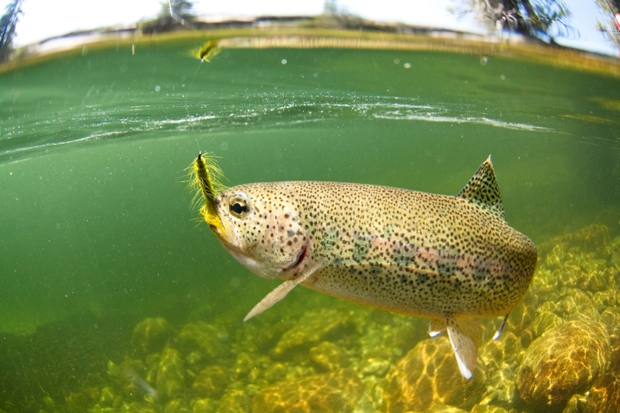Nairobi
Trout were first introduced into Kenya’s highland streams in 1905. Men like Ewart Grogan, ‘baddest and boldest of a bad bold gang’, shipped Loch Leven fingerlings in ice-packed chests to Mombasa and then up to the Rift Valley on the Lunatic Express. From there, porters carried them up into the misty, forested Aberdare and Mount Kenya slopes. Rivers with now legendary names such as Amboni, Gichugi and the two Mathioyas were stocked — and our fly fishers’ paradise was born.
Last week in Nairobi, the Kenya Fly Fishers’ — the oldest club of its kind in all of Africa — held its 95th annual dinner. It was a strictly male affair, more than 100 members and their guests. Visually it was pure H.M. Bateman. In terms of atmosphere it would make the Bullingdon seem rather left-wing.
‘Only one lady has ever dared to break the taboo,’ KFFC chairman Chris Harrison had explained to me. ‘The late Jane Froome, mother of the Tour de France cyclist Chris, attended a dinner in the 1980s dressed in black tie. Nobody made a fuss, but she decided by pudding that it was not for her, and left…’
My friend Chris Foot was one of the speakers and he rose by saying, ‘The last time I saw this many Wazungu in one room was in 1963 — when you lost!’ Some 52 years after Uhuru, Foot is from among the more indigenous members, but also a Molo wheat farmer and head of our national movie commission. He’s an accomplished piscator and his speech was all double entendres about rivers that were like past loves: the Laerdal in Norway, the Vatnsdala in Iceland, the Kennet in Britain, the Kericho in our western tea estates and the river that took his virginity — the Kiptiget in Kenya’s Mau forest.
After a very ebullient dinner I had to give a speech too. I’m not a member of the KFFC, even though I’m a fanatical fly fisherman. Clubs tend not to let me in. I spoke about how I’ve spent almost every episode of my life trying to fly fish, even in sundry war zones like the Balkans. How, since childhood, fishing has given me my happiest of memories — and how, even as we become more decrepit with age, we become better fishermen.
From what I can recall it went down OK. I didn’t get scragged. Just before dawn we were racking up billiards but not one of us could hit a ball, not even at a corner pocket when the chairman was lying on the table with his legs in the air.
I think it’s truly wonderful that a club such as the Kenya Fly Fishers’ has thrived for nearly a century. After the first world war, veterans — many of them badly maimed — came out to help build Kenya. As Harrison says, ‘Men seeking peace after the war found solace on the many rivers and streams they found here.’
By 1928 trout were being protected by law and Kenya’s colonial rulers took fishing so seriously that one lawmaker said, ‘No right-minded individual will underestimate the importance to any country of trout…’
It’s always been some of the most exciting trout fishing in the world, as my 90-year-old mother Doreen reminded me. In 1936 my father Brian bought a 3,000-acre farm on the Aberdares — solely because the Amboni river ran through it. My mother recalls how once a female neighbour hooked up a handsome trout, only to have a leopard jump out of a tree and try to steal the fish as she played it. The lady’s two Alsatian dogs had to fight the leopard for the fish before she could land her trout.
The KFFC, founded in 1919, stocked the Northern and Southern Mathioya rivers where members have fished ever since. Last year they caught 984 fish, killing 140. The record fish in 2014 was 3lb, which at the dinner earned the winner a trophy called the Harrison Horn — made from an elaborate hunting contraption that the chairman liberated from a German house of ill repute in 1983.
By the 1930s Kenya had more than 3,000 miles of pristine trout waters. Harrison reckons there are just 30 miles today, though I think it’s much more — with some excellent tarns and dams too. It’s true that many of Kenya’s streams have been destroyed, by deforestation and other kinds of environmental degradation. But still, it’s incredible that the club’s two huts on the Mathioya rivers have been going for so long, with generations of trained ghillies working along defined beats.
To this day the club stocks its rivers twice annually, employs dozens of people and uses the top-level skills of several of its agronomist members to advise local tea farmers on alternative crops that boost horticulture exports such as passion fruit and tree tomatoes. The club sponsors local schools and supplies them with science and computer labs and libraries.
Harrison says, ‘It’s ironic that the camps and rivers lie in the heart of Kikuyu land, where conflict was fiercest during the Emergency (in the 1950s, before independence). Perhaps it’s a great example of how forgiving Africa can be and how we can all rub along…’
And the fishing is still very good.







Comments